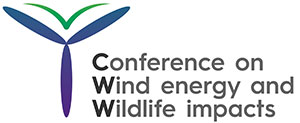BRI is helped to organize two workshops:
(1) Collision Risk Models at 40: A Workshop to Assess the State of CRMs, Identify Approaches to Improve Global Utility, and Assess Interest in a CRM Workgroup.
Workshop organizers: Kate Williams, Evan Adams, and Andrew Gilbert, Biodiversity Research Institute; Aonghais Cook, British Trust for Ornithology; Pamela Loring, U.S. Fish and Wildlife Service.
The first collision risk model (CRM) was published in 1983. Forty years later, we identified key avenues to continue improving CRMs for use in terrestrial and marine contexts worldwide. The goals of the workshop were to (1) Review different CRM approaches around the globe, including models in development and currently in use, (2) Discuss emerging topics, including integrating different data types/taxa/life history stages into density models and developing better frameworks for estimating cumulative impacts with CRMs, and (3) Identify interest in developing a global working group focused on these issues, as well as potential end products and funding sources for the working group.
During this workshop, BRI’s Andrew and Evan gave a talk on SCRAM: Using movement data to predict collision risk for endangered shorebird and seabird species in the U.S. Atlantic
(2) Where do you start? Conceptional Framing of Compensatory Mitigation for Onshore and Offshore Wind Farms
Workshop organizers: Atma Khalsa, Avangrid; Scott Johnston, U.S. Fish and WIldlife Service; Laura Nagy, and Kate Williams, Biodiversity Research Institute
In this panel, a conceptual framework was introduced that developers and regulators must navigate to identify and enact compensatory mitigation efforts, from high level determination of focal species/habitats for mitigation and opportunity identification (i.e., actions to increase survival or conserve habitat) to a narrower list of feasible options for mitigation actions, to creating the supporting logic and metrics to determine the appropriate mitigation levels and measure outcomes. Following this introduction, panelists highlighted: 1) examples of where cooperation between the permitting agency and developer allowed creative solutions to move forward, 2) how sharing of information among cooperating partners and experts can provide substantive insight and lead to better outcomes, 3) where well-intentioned regulatory language can result in conflicts between regulatory requirements and biologically meaningful solutions, and 4) similarities and differences in how the conceptual framework for compensatory mitigation may also apply to net positive impact goals.
More information on CWW workshops is available here: https://cww2023.org/eng-
Below are additional CWW presentations that feature BRI staff as co-authors and/or presenters.
- Guidance for pre- and post-construction monitoring to detect changes in marine bird distributions and habitat use related to offshore wind development. Authors: Julia Gulka, Edward Jenkins, Kate McClellan Press, Caleb Spiegel, Iain Stenhouse, Tim White, Kate Williams. Julia Gulka from BRI is presenting this oral presentation.
- Synthesizing multi-scale relationships between forage fishes and marine predators in the Northwest Atlantic Ocean to inform offshore wind siting. Evan Adams, Chandra Goetsch, Julia Gulka, Kevin Friedland, Andrew Gilbert, Holly Goyert, Iain Stenhouse, Kate Williams, and Arliss Winship. Evan Adams from BRI will be presenting this oral presentation.
- Recommendations for technology research and development (R&D) for scientifically robust monitoring of birds and marine mammals in relation to offshore wind energy development. Kate Williams, Sarah Courbis, Julia Stepanuk, Helen Yurek, Aude Pacini, Heidi Etter, Fabiola Campoblanco. Kate Williams from BRI will be presenting this oral presentation.
- Synthetic analysis of post-construction displacement of marine birds from wind energy areas – Juliet Lamb, Julia Gulka, Kate Williams, Evan Adams, and Aonghais Cook. Juliet Lamb with TNC will be presenting this oral presentation.
- Implementing Motus technology for offshore wind monitoring – Pamela Loring, Kate Williams, Evan Adams, Andrew Gilbert, Doug Gobeille, Erik Carlson, Stuart Mackenzie, Lucas Berrigan. Pam Loring with USFWS will be presenting this poster.
- Database of research gaps for understanding effects to wildlife and the environment from offshore wind energy development in the U.S. Atlantic. Authors: Kate Williams, Julia Gulka, Rebecca Green, Mark Severy, Hayley Farr, Frank Oteri, Kate McClellan Press. Julia Gulka and Kate Williams from BRI will be presenting this poster.
View the full program here.
BRI’s involvement at previous CWW conferences
2022
BRI’s Kate Williams served on the Scientific Advisory Committee for this Conference, and also co-organized a special session, Special Session on Cumulative Effects from Offshore Wind Energy Development – organized by Kate Williams, Biodiversity Research Institute; Aonghais Cook, British Trust for Ornithology; and Kate Searle, UK Centre for Ecology and Hydrology.
This special session focused on the European and North American offshore wind experience to: 1) describe the scientific and policy challenges associated with this issue, 2) explore approaches for improving cumulative effects assessments in the face of uncertainty, and 3) identify a path forward for improving our understanding of cumulative effects, including for regions that are still in an early development phase. The session included six scientific talks included one by Kate Williams, Developing research priorities to inform understanding of cumulative impacts from a new industry in the U.S., which was a discussion of a recent effort to prioritize key studies to better prepare American scientific and regulatory communities to assess cumulative biological impacts as the industry proceeds in the U.S.
Additionally, in a session titled “Uncertainty in risk assessments (offshore)” two oral presentations were presented by BRI Staff:
1. Integrating Motus tracking into aerofauna monitoring at offshore wind projects: Evan Adams
2. Assessing individual movement, habitat use, and behavior of non-breeding marine birds in relation to planned offshore wind development in the eastern U.S.: Julia Gulka
2019
In a session titled “Reducing uncertainty and looking forward” Kate Williams presented the talk below, which included BRI’s Julia Gulka as a co-author.
1. The Environmental and Fisheries Technical Working Groups: Stakeholder Engagement on the Responsible Development of Offshore Wind in New York State: Kate Williams, Kate McClellan Press, Gregory Lampman, LyndieHice-Dunton, Julia Gulka, Jason Gershowitz. Presented by Kate Williams, Biodiversity Research Institute
Photo Credits: Header photo © Shutterstock



